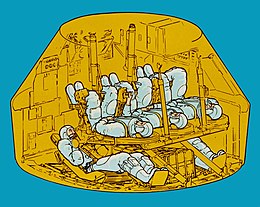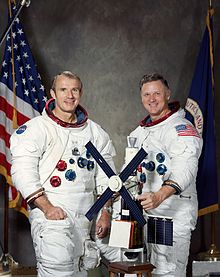Skylab Rescue

Skylab Rescue Command Module Diagram
|
|
| Mission type | Crew rescue |
|---|---|
| Operator | NASA |
| Spacecraft properties | |
| Spacecraft | Apollo CSM-119 |
| Manufacturer | North American Aviation |
| Crew | |
| Crew size | 2 at launch 5 at landing |
| Members |
Vance D. Brand Don L. Lind |
| Start of mission | |
| Launch date | On standby August 1973 - February 1974 (Unlaunched) |
| Rocket | Saturn IB AS-208/209 |
| Launch site | Kennedy LC-39B |
| Docking with Skylab | |
| Docking port | Forward |
 Skylab rescue crew portrait (Left to right; Vance Brand and Don Lind) |
|
The Skylab Rescue Mission (also SL-R) was a backup rescue flight as part of a contingency plan for the Skylab space station. It used a modified Apollo Command Module that could be launched with a crew of two and return a crew of five.
Plans for outfitting an Apollo Command/Service Module (CSM) as a space rescue vehicle date back to November 1965 when North American Rockwell technicians conceived the possibility of a rescue mission for astronauts trapped in lunar orbit. After a rescue mission in Earth orbit was depicted in the 1969 film Marooned, the company revived the concept in November 1970.Marshall Space Flight Center issued a formal Mission Requirements document on 17 May 1972, with subsequent revisions. The standard Skylab Command Module accommodated a crew of three with storage lockers on the aft bulkhead for resupply of experiment film and other equipment, as well as the return of exposed film, data tapes and experiment samples. To convert the standard CSM to a rescue vehicle, the storage lockers were removed and replaced with two crew couches to seat a total of five crewmen.
After Skylab 3 was launched, the crew's CSM developed a problem with two of its Reaction Control System thruster quads. They were leaking fuel, one failing before the CSM docked with the station and another on August 2, six days later. The malfunctions only left two available quads, and while the spacecraft could operate with just one, the leaks posed a possible risk to other systems.
NASA first considered bringing the crew home immediately. However, because the astronauts were safe on the station with ample supplies and because plans for a rescue flight existed, the mission continued while the Saturn IB rocket AS 208 with CSM 119 was assembled in the Vehicle Assembly Building at Launch Complex 39 for possible use. It was at one point rolled out to LC-39B.
...
Wikipedia
